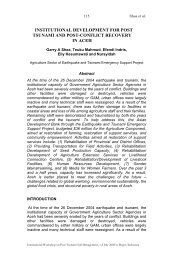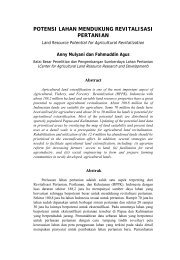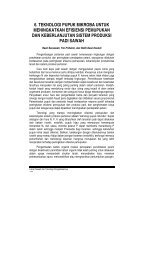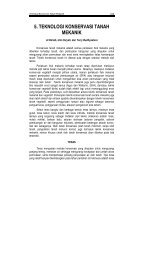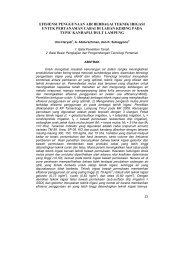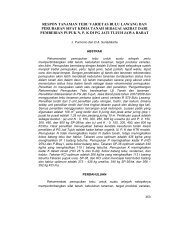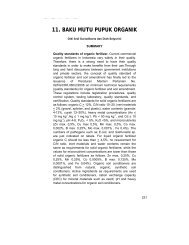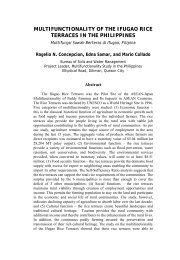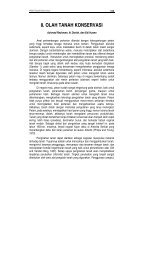Proceedings - Balai Penelitian Tanah
Proceedings - Balai Penelitian Tanah
Proceedings - Balai Penelitian Tanah
Create successful ePaper yourself
Turn your PDF publications into a flip-book with our unique Google optimized e-Paper software.
146<br />
Wahyunto et al.<br />
and coconut, manggo, rambutan, banana and peniaple. The limiting<br />
factors are water inundation and low nutrient content<br />
MU 18 (deep peat with peat depth >3 meters, peat depth localized<br />
areas reach 6 to 9 meters). This unit is not suitable for agriculture,<br />
recommended for conservation due to it’s fragile ecosystem.<br />
PMU 19 (levee) both unit are moderately suitable for coconut, coffee,<br />
duku, durian, manggoesten, rambutan pineaple, mung bean, long<br />
bean, soy bean, peanut, mustard, sweet potato and cassava. The<br />
limiting factors are low nutrient and water inundation<br />
PMU 11, 12, 20, 21, 22 and 23 (swalle, river backswamp, narrow<br />
criver valley, alluvio-marine deposits dominated by aquepts and<br />
aquents soil are moderately suitable for paddy. The major limiting<br />
factors is low nutrient availability<br />
PMU 24 and 28 (alluvial plain and undulating tectonic plain), both unit<br />
are moderately to marginally suitable for rubber, oil palm and paddy.<br />
The major limiting factor is low nutrient availoability and drainage<br />
assessibility.<br />
PMU 25, 26 and 27 (undulating to rolling tectonic plain) are suitable<br />
for rubber, oil palm, cacao, clove, banana, coconut, duku, durian,<br />
papaya, banan. The limiting factors are low nutrient and erosion<br />
hazard.<br />
Landuse Recommendations<br />
Numerous potential land-use for certain crops are feasible and can be<br />
identified by land evaluation of each physiographic mapping unit. To<br />
interpret the combination of land suitability class, screening is<br />
necessary based on the priority of regional/district development<br />
(Rencana Tata Ruang Daerah) and existing landuse. In the screening<br />
for annual food crops and vegetable crops, only S1 and S2 classes<br />
are considered, but for the perennial tree crops, S3 or marginally<br />
suitable class is also included because of the higher priority of the<br />
current project on perennial tree crops suitability evaluation.<br />
The approach in screening of land suitability is given in Table 2. The<br />
land that is currently being utilized, especially for perennial tree crops/<br />
estate crops and paddy field fields are left as such as long as they fall<br />
into suitable class. Those lands may be recommended for<br />
intensification for increasing their productivity. Land that currently are<br />
not optimally used or not being used such as shrub, conversion forest,<br />
or absentee agricultural land were recommended for extensification<br />
for other suitable commodities. Landuse recommendation for Aceh<br />
Barat district coastal areas post calamity is presented in Table 3 and<br />
Figure 1 (Agricultural Recommendation map for West Coast of Aceh<br />
Barat District).<br />
International Workshop on Post Tsunami Soil Management, 1-2 July 2008 in Bogor, Indonesia



